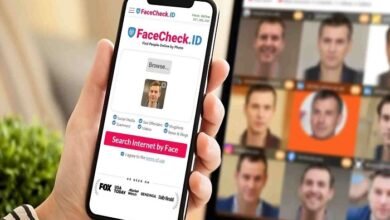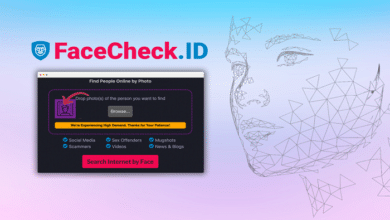Face Check ID: Technology, Benefits, and Security Concerns

Face Check ID is a cutting-edge technology designed to enhance identity verification processes using facial recognition. By leveraging advanced algorithms, Face Check ID enables secure and efficient identification of individuals based on their facial features. This technology has gained traction in various fields, from security and finance to everyday consumer applications. In this blog post, we’ll explore how Face Check ID works, its benefits, applications, and the security considerations you need to be aware of.
How Face Check ID Works
Face Check ID operates by analyzing unique facial features to verify identity. The process begins with capturing an image of an individual’s face through a camera or mobile device. Face Check ID then uses sophisticated algorithms to map facial landmarks, such as the distance between eyes and the shape of the jawline. This data is compared to stored facial templates in a database to confirm identity. The accuracy and speed of Face Check ID make it a reliable tool for various identification needs.
Benefits of Using Face Check ID
Face Check ID offers numerous benefits that enhance both security and convenience. One of the primary advantages is its ability to provide contactless and fast identity verification. This is particularly useful in environments where speed and efficiency are crucial, such as airports or financial institutions. Additionally, Face Check ID reduces the need for physical ID cards or documents, streamlining processes and minimizing the risk of identity theft. Overall, Face Check ID simplifies and secures identity verification.
Applications of Face Check ID
The applications of Face Check ID span a wide range of industries and use cases. In the security sector, Face Check ID is used to control access to secure areas and monitor surveillance footage for suspicious activity. In finance, it enhances the security of online transactions and account access by verifying users’ identities. Additionally, Face Check ID is increasingly used in consumer applications, such as unlocking smartphones and personalizing user experiences. The versatility of Face Check ID makes it a valuable tool across various domains.
Face Check ID in Security and Surveillance
In the realm of security and surveillance, Face Check ID plays a crucial role in enhancing safety and efficiency. It is used to verify the identities of individuals accessing restricted areas, reducing the risk of unauthorized entry. Face Check ID also aids in monitoring public spaces by identifying individuals in real-time from surveillance footage. This application is particularly useful for law enforcement agencies and security personnel who need to quickly and accurately identify individuals of interest.
Face Check ID in Financial Services
Face Check ID has revolutionized the financial services industry by providing an additional layer of security for online transactions and account management. Banks and financial institutions use Face Check ID to authenticate users during login and authorize transactions, reducing the risk of fraud and identity theft. By integrating Face Check ID into their systems, financial services can offer a more secure and user-friendly experience, ensuring that only authorized individuals can access sensitive information and perform financial operations.
Privacy Concerns with Face Check ID
Despite its benefits, Face Check ID raises significant privacy concerns that need to be addressed. The collection and storage of facial data pose risks related to data breaches and unauthorized access. Additionally, there are concerns about the potential misuse of facial recognition technology for surveillance and tracking without consent. To mitigate these privacy concerns, it is essential for organizations using Face Check ID to implement robust data protection measures and comply with relevant privacy regulations.
Security Measures for Face Check ID
To ensure the security of Face Check ID systems, several measures should be in place. First, facial data should be encrypted both during transmission and storage to protect it from unauthorized access. Regular security audits and vulnerability assessments are also crucial to identify and address potential risks. Additionally, organizations should implement strict access controls to limit who can view and manage facial data. By adopting these security measures, organizations can safeguard Face Check ID systems and protect users’ personal information.
Comparing Face Check ID with Other Authentication Methods
When comparing Face Check ID with other authentication methods, such as passwords and biometric fingerprints, each has its own advantages and limitations. Face Check ID offers a contactless and convenient authentication experience, but it can be vulnerable to spoofing or privacy concerns. Passwords are widely used but can be easily forgotten or compromised. Fingerprints provide a high level of security but require physical contact. Understanding the strengths and weaknesses of each method helps in selecting the most appropriate authentication solution for different scenarios.
Future Trends in Face Check ID Technology
The future of Face Check ID technology looks promising, with ongoing advancements aimed at improving accuracy and expanding applications. Emerging trends include the integration of Face Check ID with artificial intelligence and machine learning to enhance recognition capabilities and adapt to changing conditions. Additionally, advancements in privacy-preserving techniques, such as federated learning, aim to address privacy concerns while maintaining the effectiveness of Face Check ID. As technology evolves, Face Check ID will continue to play a significant role in secure and efficient identity verification.
Conclusion
Face Check ID represents a significant advancement in identity verification technology, offering numerous benefits across various sectors. Its ability to provide fast, secure, and contactless authentication makes it a valuable tool for enhancing security and convenience. However, it is essential to address privacy and security concerns associated with facial recognition technology to ensure its responsible and effective use. By understanding the capabilities and challenges of Face Check ID, organizations and individuals can make informed decisions and leverage this technology to improve their identity verification processes.
FAQ
- What is Face Check ID?
- Face Check ID is a facial recognition technology used for identity verification by analyzing unique facial features to confirm an individual’s identity.
- How does Face Check ID work?
- Face Check ID captures an image of a person’s face, analyzes facial landmarks, and compares them to stored facial templates to verify identity.
- What are the main benefits of using Face Check ID?
- Benefits include fast and contactless verification, reduced need for physical ID cards, enhanced security, and convenience in various applications.
- What are the privacy concerns related to Face Check ID?
- Privacy concerns include the risk of data breaches, unauthorized access to facial data, and potential misuse for surveillance without consent.
- How can organizations ensure the security of Face Check ID systems?
- Organizations can ensure security by encrypting facial data, conducting regular security audits, implementing access controls, and complying with privacy regulations.





